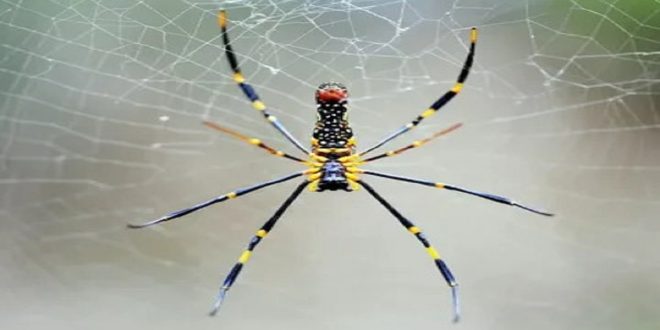A banana-spider is a name that could refer to a variety of spider species, most often those of the gold orb weaver spider (genus Nephila) or the Brazilian wandering spider (Phoneutria). Both have earned their nicknames for diverse reasons. They are captivating creatures that have caught the interest of both arachnologists and people of all ages due to their striking look, distinctive web-building skills, and intricate behavior. We’ll examine different aspects of banana spiders, focusing on their behavior, characteristics in their habitats, and relationships with people. This overview will discuss these arachnids’ science, myths, and ecological significance.
Introduction to Banana Spiders
“Banana spider” is a term that can be misleading. “Banana spider” can be inaccurate because it refers to various kinds of spiders based on location. The term “banana spider” is used in North America; it usually refers to golden orb weavers renowned for their vast dimensions and bright yellow webs. For South America, however, the term often refers to Brazilian wandering spiders notorious for their deadly venom and abrasive nature.
Previous encounters with banana spiders, often found in banana shipments during the 19th and early 20th centuries, have caused the confusion around the term. People now use the term to describe various spiders associated with tropical habitats and bananas, regardless of their biological classification. Whatever the term’s origin, the banana spiders are fascinating creatures that display fascinating behavior and play an essential part in ecology.

Taxonomy and Types of Banana Spider (Species Classification)
Golden Orb-Weaver (Genus Nephila)
The golden orb weaver (Nephila) is among the most popular banana spiders. They are part of the Araneidae family and are renowned for their golden-colored silk that they use to create giant, intricate webs. The Nephila genus Nephila encompasses a range of species including:
- Nephila clavipes: Found throughout the south of the United States, Central America, and South America.
- Nephila pilipes: Found in parts of Asia and the Pacific region.
They are non-aggressive and are often appreciated for their stunning look and intricate webs.
Brazilian Wandering Spider (Phoneutria)
However, This Brazilian wandering spider is a member of the Ctenidae family and is considered one of the most poisonous spiders in the world. The species of this genus, especially Phoneutria, the nigriventer, are renowned for their potent neurotoxic venom and unpredictable wandering behavior since they don’t spin webs to capture prey. They originate from South America and have a higher risk of being dangerous than golden orb weavers.
Habitat and Distribution
Golden Orb-Weavers
Golden orb-weavers favor subtropical and tropical habitats. These golden banana spiders are typically located in southern areas of the United States, Central and South America, Southeast Asia, and areas of Africa and Australia. They usually weave large webs in open areas like forests, gardens, and walking paths, giving them plenty of space to capture flying insects.
They thrive in warm, humid conditions and often spin webs between plants or trees in natural areas.
Brazilian Wandering Spiders
Brazilian roaming spiders, as the name implies, can be located throughout South and Central America, with a high concentration in the tropical forests of Brazil. In contrast to orb-weavers, they are not confined to the same place and can make webs. Instead, they swarm the forest floor looking for prey and hide in crevices, rocks, or artificial structures. This is why they often get caught in cargoes of bananas.
Physical Characteristics
Golden Orb-Weavers
Golden orb weavers are among the most enormous spiders in the world. Females are generally more prominent than males, and females can attain the size of two inches (5 centimeters) in body length with leg spans as high as six inches (15 centimeters). Males, however, are considerably smaller, usually smaller than half the size of females.
The distinctive characteristic of these species is their vivid black and yellow coloration and the golden color in their webs. The yellow color helps them conceal themselves against the sun since it blends into the green leaves, which makes it hard for predators to detect the webs.
Brazilian Wandering Spiders
Brazilian wandering spiders are giant with a body length that can reach the size of two inches (5 cm) and a leg span of 5- 6 inches (12-15 cm). They’re typically greyish or brown in hue with distinct dark stripes along their legs. Their solid and venomous fangs and swift, unpredictable moves make them slightly intimidating.
Banana Spider Web-Building and Hunting Behavior
Golden Orb-Weavers
Golden orb-weavers are renowned for their web-building skills. Their webs can extend many feet wide and are made of sturdy golden-colored silk. Silk is strong and highly sticky, allowing spiders to capture a range of prey species, from tiny insects to larger animals such as bats or birds.
The spiders are in the middle of their webs and wait for their prey to get caught up. If an insect is caught in this web, it swiftly imprisons it with venom before wrapping it in silk, which it consumes later.
Brazilian Wandering Spiders
Brazilian wandering spiders can be avid hunters and do not depend on webs to capture prey. Instead, they use their incredible ability to speed up and move quickly to chase smaller mammals, insects, or even spiders. Their poison is robust and satisfying to rapidly incapacitate or kill the prey, making them very effective hunters.
Banana Spider Venom: Are Banana Spider Dangerous?
Golden Orb-Weavers
While golden orb-weavers are massive and can look intimidating, these animals are not considered dangerous to human health. Their venom is gentle and is mainly used to fend off their prey. Golden orb-weavers’ bites are sporadic. Localized pain, swelling, and redness are typically mild when they occur. These banana spiders are usually non-aggressive and will only bite when they are in self-defense.
Brazilian Wandering Spiders
On the other hand, Brazilian wandering banana spiders are highly poisonous and potentially dangerous for humans. The venom of these spiders contains neurotoxins that could cause extreme pain, muscle paralysis, and, in extreme cases, respiratory failure. However, the risk of fatal bites is shallow because antivenoms are widely accessible in areas where spiders are prevalent. Most interactions with Brazilian wandering banana spiders will not result in bites as they typically run away when threatened.

Banana Spider Reproduction
Golden Orb-Weavers
Golden orb-weavers show sexual dimorphism, which means females are bigger than males. When mating, males cautiously move towards females and often wait at the edges of their webs to prevent being considered prey. After mating successfully, females lay eggs in silk sacs, which they guard until the spiderlings emerge.
Brazilian Wandering Spiders
Brazilian roaming spiders are sexually dimorphic, with females being more imposing. Mating rituals for these spiders can be dangerous, as males must be cautious when approaching females to avoid being threatened. Females make egg sacs when they meet and protect them vigorously until the spiderlings are born.
Banana Spiders in Mythology and Popular Culture
Banana spiders have appeared in myths, legends, and popular art worldwide. In diverse cultures, the gold orb-weaver’s webs represent the power of creativity, patience, and artistic talent due to their massive, complex designs. In folklore, people often view spiders as defenders of the forests or harbingers of rain, depending on the locale.
Popular media frequently portrays Brazilian wandering spiders as venomous and dangerous creatures in both literature and films, contributing to their terrifying reputation.
Ecological Role and Importance
Banana spiders play an essential part in the ecosystem by regulating the population of insects. They are predators and help keep the balance in place by controlling the number of mosquitoes, flies, and other insects. Orb-weavers’ webs, specifically, catch many insects, making them crucial for reducing pest populations in both natural and agricultural habitats.
In tropical environments, banana spiders are often prey for larger species of animals, like small mammals and birds, and are an essential component in the food chain.
Banana Spiders and Human Interaction
While banana spiders, specifically golden orb-weavers, are beneficial to humans due to their ability to control pests, Brazilian wandering spiders are a risk because of their venomous bites. However, human interactions with spiders are usually infrequent. Experts advise humans to respect the spiders’ space and avoid unnecessary contact in regions where banana spiders are common.
Suppose you encounter banana spiders in their home or gardens. In that case, it is recommended to be left alone or move them carefully because they’re not aggressive and will likely bite unless provoked.
Conservation and Threats
The protection of the banana spider is not a huge concern because they aren’t listed as endangered. However, like other species, they are at risk due to the loss of habitat caused by deforestation, the expansion of agriculture, and urbanization, especially in tropical regions in which they are prevalent. In addition, changes to weather and pesticide usage may negatively affect their populations as they alter their food and habitats. Despite these challenges, they are essential to conserving ecological balance and preserving their natural habitats, which aids in ensuring their long-term existence.
Conclusion
In conclusion, banana spiders, whether the golden orb weaver or the Brazilian wandering spider, are fascinating and varied creatures that play a crucial role in their ecosystems. Golden banana spiders are loved for their elaborate webs and non-threatening environment, while Brazilian wandering spiders are recognized for their powerful venom and active hunting behaviors. Both species illustrate the diversity of nature and the necessity for awareness of their ecological value and conservation. Despite their sometimes-fearsome reputation, banana spiders are a source of great pleasure.
FAQs
How venomous is a banana spider?
People know golden orb-weaver spiders for their moderate venom, which is non-toxic to humans. Yet, Brazilian wandering spiders, sometimes called banana spiders, possess a venom with a high potency that is potentially dangerous but rarely fatal.
Why is it called the banana spider?
People named the banana spider because they frequently find it in bananas, especially the Brazilian wandering spider. In some regions, they also use the term for golden orb-weavers, known for living in tropical areas where bananas grow.
What happens if you get bitten by a Brazilian wandering spider?
A bite from a Brazilian wandering spider’s bite may cause severe muscle cramps, pain, and, in some cases, more severe symptoms, such as difficulty breathing. Experts advise humans to respect the spiders’ space and avoid unnecessary contact in regions where banana spiders are common.
Is Phoneutria poisonous?
Phoneutria, sometimes referred to by the name of Brazilian wandering squirt, can be highly venomous. The bite of this spider may cause extreme pain and possibly deadly symptoms, but fatal cases are sporadic if you receive appropriate medical treatment.
How do banana spiders eat?
Banana spiders, like golden orb-weavers, bind their prey using venom, cover it with silk, and liquefy it using digestive enzymes before eating it. They feed primarily on insects that are caught inside their webs.
What is the biggest spider in the world?
The Goliath birdeater (Theraphosa Blondi) is a species of Tarantula found throughout South America. It is the largest spider on earth in terms of weight, with legs that span up to 12 inches (30 cm).
 aim specialty health Discover Expert Insights, Empower Your Wellness With Aim Specialty Health Blogs.
aim specialty health Discover Expert Insights, Empower Your Wellness With Aim Specialty Health Blogs.




